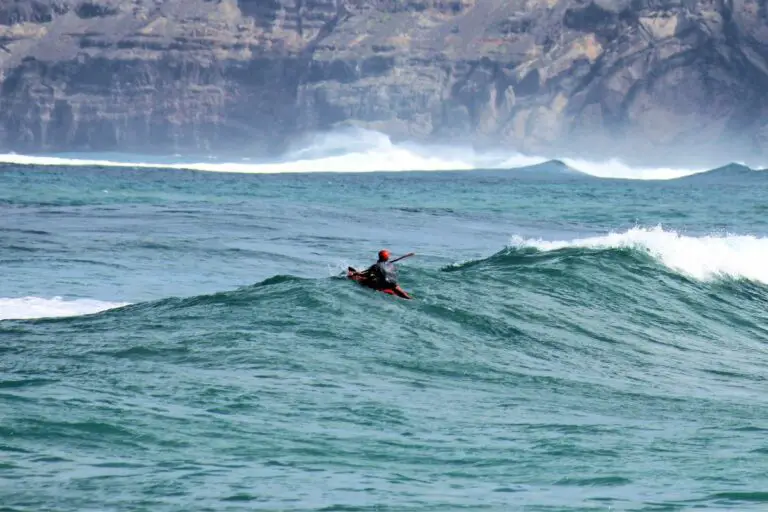Does Kayaking Make You Seasick? 10 Symptoms & How to Avoid Them
For many people, the allure of kayaking lies in the sense of adventure and the opportunity to explore the open water. However, for some, the fear of seasickness can be a significant barrier to fully enjoying this experience.
So, does kayaking make you seasick? And is there anything you can do to overcome it or prevent it from happening?
Kayaking can cause seasickness in some individuals due to the motion of the kayak on the water, but it is not a universal experience and can be prevented with proper preparation and techniques, including staying hydrated and focusing on the horizon while paddling.
Keep reading to learn more about the symptoms of seasickness and how to avoid getting seasick while kayaking.
Table of Contents
Does Kayaking Make You Seasick?

Seasickness is a type of motion sickness that can occur when the brain receives conflicting signals from the eyes and the inner ear, which sense different motions.
Kayaking can cause seasickness in some individuals, as the motion of the kayak on the water can lead to a similar sensory conflict. However, not everyone experiences seasickness while kayaking, as factors such as sea conditions, the length of the trip, and personal susceptibility can play a role.
Who Is More Prone to Seasickness?
As I mentioned earlier, some people are more prone to seasickness than others; this includes people who are more susceptible to motion sickness in general, such as those who experience car sickness or air sickness.
Additionally, women, children, and individuals with inner ear disorders or certain medical conditions may also be more prone to seasickness. There may also be some psychological factors, such as anxiety and stress, that can also contribute to seasickness susceptibility.
What Are the Symptoms of Seasickness?
The symptoms of seasickness may include:
- Nausea and vomiting
- Dizziness or lightheadedness
- Sweating
- Headache
- Fatigue
- Loss of appetite
- Pale skin
- Increased salivation
- Rapid breathing
- Feeling generally unwell
Symptoms of seasickness can range from mild to severe and may vary from person to person. They typically occur within a few hours of exposure to motion and can persist even after the motion has stopped.
Keep in mind that experiencing these uncomfortable symptoms while kayaking may put you in danger. So, it’s important to take steps to prevent and manage seasickness to ensure your safety while kayaking.
How to Avoid Getting Seasick on A Kayak?

While kayaking can cause seasickness in some individuals, it can be prevented with proper preparation and techniques.
So, here are some tips to help you avoid getting seasick while kayaking:
- Choose calm water: Select calm, protected waters for your kayaking trip, as rough seas can increase the likelihood of seasickness.
- Stay hydrated: Drink plenty of water before, during, and after your kayaking trip to stay hydrated and prevent dehydration, which can exacerbate seasickness.
- Avoid alcohol and caffeine: Both alcohol and caffeine can dehydrate the body and increase the likelihood of seasickness.
- Eat light: Eat a light, easily digestible meal before kayaking, and avoid heavy or greasy foods that can contribute to nausea and indigestion.
- Focus on the horizon: Look at the horizon or a fixed point in the distance to help stabilize your inner ear and reduce sensory conflict.
- Take breaks whenever needed: Take regular breaks during your kayaking trip to rest and prevent fatigue.
- Pack medication: Over-the-counter or prescription medications, such as antihistamines or scopolamine patches, can help prevent or alleviate seasickness but keep in mind that any medication should only be used under the guidance of a healthcare professional.
- Pack ginger: Ginger has natural anti-nausea properties and can be consumed in various forms, such as ginger tea or ginger candies.
By following these tips, you can reduce your risk of seasickness and enjoy a comfortable kayaking experience.
What to Do If You Get Seasick?
If you start feeling seasick while kayaking, there are several steps you can take to alleviate your symptoms:
- Stop paddling immediately: Stop paddling and take a break to rest and allow your body to adjust to the motion of the kayak.
- Change positions: Changing your seating position in the kayak or moving your body can help reduce nausea and dizziness.
- Focus on the horizon: Look at the horizon or a fixed point in the distance to help stabilize your inner ear and reduce sensory conflict.
- Practice breathing techniques: Use slow, deep breathing techniques to help relax your body and reduce anxiety and stress.
- Consider medication: If you’ve packed medications for seasickness, such as antihistamines or scopolamine patches, make sure to use them to alleviate some of the symptoms of seasickness.
If your seasickness symptoms persist or become severe, it may be best to end your kayaking trip and seek medical attention if necessary.
Conclusion
In conclusion, seasickness can be a distressing condition that can occur to some individuals. The symptoms can range from mild to severe, but there are likely several measures that can help to reduce the risk of developing symptoms and alleviate the discomfort so you can enjoy your kayaking trip to the fullest.
If you’re new to kayaking or prone to seasickness, start with shorter trips in calm waters and gradually increase the duration and intensity of your outings as your body becomes more acclimated to the motion.
Remember, everyone’s body is different, and what works for one person may not work for another. It may take some trial and error to find the strategies that work best for you to avoid seasickness while kayaking.
Kayak your way to Freedom
- On a budget? Check out the best fishing kayaks under $500 here and the best Fishing Kayaks under $1,000 here. Or Check the best Cheap Kayaks here.
- Going fishing? Here are the best Ocean fishing kayaks, and here are the best River Fishing Kayaks.
- You can also find the best Fly Fishing Kayaks here and the best Bass Fishing Boats here.
- A bit experienced? Check out the best modular kayaks here and the best tandem fishing kayaks here.
- Looking for something special? Check out my favorite Ducky kayaks here.
- Navigate your way with these awesome and beginner-friendly Kayak compasses.
- Going Hunting? These Duck hunting kayaks will give you an unfair advantage!
- Have a need for speed? These motorized kayaks will get you moving.
- Protect yourself from the sun with these Kayak shades, and make your kayak more comfortable with these Kayak seats.
- Keep your feet dry and warm with these superb Kayaking shoes.
- Going Kayaking in cold water? Stay warm with these Kayaking gloves.
- Paddle Less, Fish More with the Best Kayak Motors
- Looking to get a trolling motor on your kayak? Check out the best kayak trolling motor mounts here.
If you like this article, please share it or pin it, you can find the share buttons below. We will really appreciate it ❤️



![Which Is Easier: Canoeing Or Kayaking? [Pros & Cons]](https://outdoorskilled.com/wp-content/uploads/2021/11/canoe-vs-kayak-768x512.jpg)

![The 6 Best Kayak Shades and Canopies [Real-Life Tests, 2023]](https://outdoorskilled.com/wp-content/uploads/2021/07/best-kayak-shades-featured-768x512.jpg)
